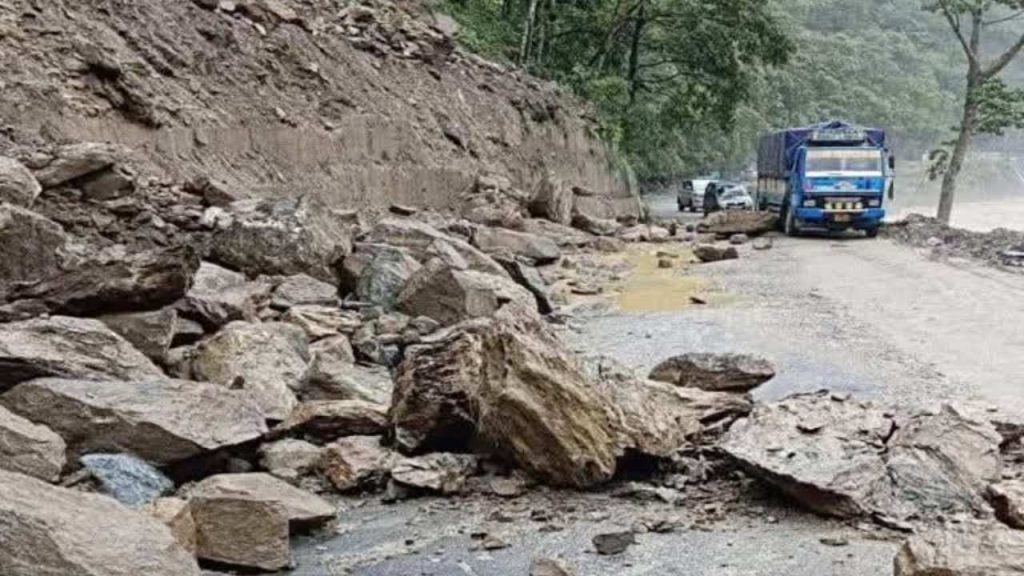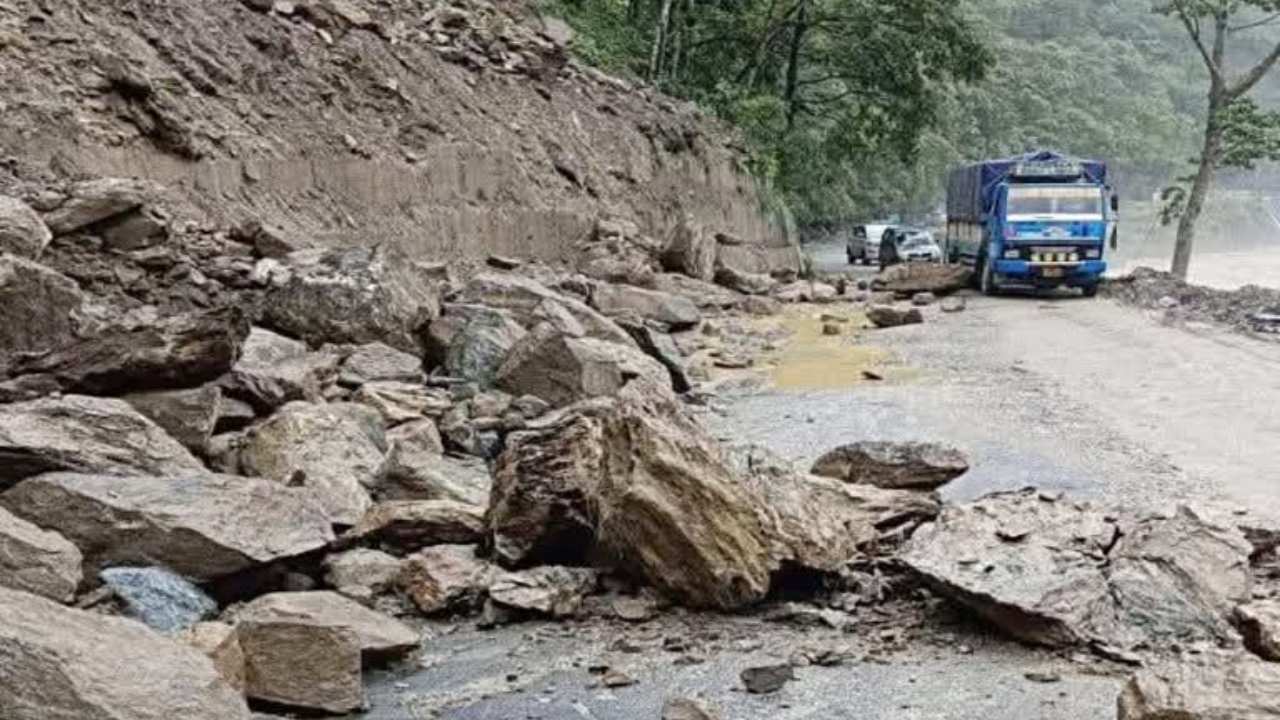A recent landslide in the Sundargarh district of Odisha, India, has caused significant disruption along National Highway 520 (NH-520), also known as the Koida-Chunaghati stretch. The event, which took place after continuous rainfall in the region, has affected the smooth flow of traffic, with large boulders, uprooted trees, and debris blocking the highway. This critical stretch is especially important for transporting minerals and supplies, making the situation all the more critical for the local economy.

In this article, we’ll break down the causes and consequences of the landslide, explain how authorities are managing the situation, and provide advice for travelers who are impacted by this unforeseen event. Whether you’re a local resident, a professional in the transportation sector, or simply curious about the effects of landslides on infrastructure, we’ve got you covered.
Landslide Blocks NH 520 in Odisha’s Sundargarh
| Key Information | Details |
|---|---|
| Location | Koida-Chunaghati stretch, National Highway 520, Sundargarh district, Odisha |
| Date of Incident | July 2025 |
| Cause of Disruption | Continuous rainfall leading to soil erosion, boulders, and uprooted trees blocking the highway |
| Key Concern | Developing cracks in the guard wall at Chunaghati, indicating potential instability |
| Local Impact | Disruption in the transportation of minerals and supplies; significant impact on the local mining economy |
| Official Action Taken | National Highways Authority of India (NHAI) has initiated debris clearance operations; local authorities are urging the public to avoid unnecessary travel in the area |
| Alternative Routes | Travelers are advised to check local news channels and official announcements for updates on alternate routes and real-time information on the road status |
| Official Reference | Official NHAI Announcement |
The landslide blocking NH-520 in Odisha’s Sundargarh district is a reminder of the delicate balance between nature and infrastructure. It shows just how quickly weather events can disrupt essential roads, which are critical for the transportation of goods and the economic activity of entire regions. While authorities are working hard to clear the debris and restore normal traffic flow, travelers and local residents alike should stay informed and exercise caution.
In the long run, a combination of improved infrastructure, early-warning systems, and environmental conservation can help mitigate the impact of future landslides. Stay safe and keep updated with official announcements for the best route options.
What Happened and Why Does It Matter?
A landslide along National Highway 520 (NH-520) in the Sundargarh district of Odisha has disrupted traffic on one of the region’s most important roads. The highway is a vital link in the region’s transportation network, providing access to key mining areas that depend on the smooth movement of goods and supplies. This disruption, caused by continuous rainfall, has led to massive boulders and debris blocking the road, further complicating an already difficult situation.
Understanding the Impact of Landslides on Infrastructure
Landslides like this one can have a dramatic impact on infrastructure, especially in areas with a lot of rainfall or where the landscape is prone to erosion. This specific landslide occurred after continuous rain fell on the region, making the soil unstable. The resulting erosion caused large rocks, soil, and trees to cascade onto the road, effectively blocking the highway.
National Highway 520 is particularly crucial for the transportation of minerals and other resources from mining operations in the region. The disruption not only affects local traffic but also has a ripple effect on industries that rely on this route. For example, mining companies in the area often use this road to transport valuable materials to factories and distribution centers.

The Role of the National Highways Authority of India (NHAI)
In response to the landslide, the National Highways Authority of India (NHAI) has launched debris clearance operations to restore normal traffic conditions. NHAI teams are working hard to clear the road, but the challenge is not just about removing the debris. There are also concerns about the safety of the road, especially considering the developing cracks in the guard wall at Chunaghati. These cracks suggest that the area may be at risk of further instability, which could delay repairs and create ongoing hazards for travelers.
Key Factors Contributing to Landslides in Odisha
Landslides in hilly or mountainous regions like Odisha are not uncommon, especially during the monsoon season. Here’s a breakdown of the factors contributing to this particular incident:
- Heavy Rainfall: The region has experienced heavy rains over the past few weeks, which led to soil saturation. When the soil becomes too saturated, it loses its strength and begins to slide down the slopes, carrying debris with it.
- Erosion: Many regions in Odisha are prone to erosion, especially in areas where roads are built close to steep hills or cliffs. Erosion weakens the soil structure, making it more susceptible to landslides.
- Human Activity: Road construction, mining, and other human activities can disturb the natural balance of the land, making it more prone to landslides. In areas like Sundargarh, mining operations can create unstable ground conditions.
- Geological Conditions: The region’s geology also plays a role. The rocky and steep landscape of Sundargarh makes it more vulnerable to landslides, especially during the monsoon season.
What Should Travelers Do?
If you’re planning to travel through the Sundargarh district or use NH-520 anytime soon, here’s what you need to know:
- Avoid Unnecessary Travel: Local authorities are urging travelers to avoid unnecessary travel through the affected region. With the road blocked and the potential for further instability, it’s best to postpone your trip if possible.
- Monitor Updates: Keep an eye on local news channels and government websites for real-time updates on the status of the road and alternative routes. The situation is fluid, and road conditions may change quickly.
- Consider Alternative Routes: Travelers should consider taking alternative routes if they need to pass through the region. Local authorities are likely to provide recommendations and guidance on safer routes.
- Stay Safe: Be cautious when traveling in regions affected by landslides. Even if roads are cleared, there may be lingering hazards such as loose soil or unstable rock formations that can pose a risk.
How Does This Impact the Local Economy?
The local economy, particularly in mining-dependent areas like Sundargarh, is feeling the strain of the NH-520 disruption. Mining operations in the region rely heavily on the smooth flow of transportation for the movement of goods. A disrupted highway means delays in shipments, leading to operational setbacks for businesses and industries in the area.
Sundargarh is part of Odisha’s rich mining belt, known for its vast deposits of coal and iron ore. The region plays a crucial role in the supply chain for industries across India. If the situation is not addressed quickly, these disruptions can snowball into greater economic consequences, affecting the livelihoods of thousands of workers and business owners.
How Can We Prevent Future Landslides?
While we can’t completely eliminate the risk of landslides, there are steps that can be taken to mitigate the damage:
- Improved Drainage Systems: Proper drainage systems along highways can help prevent the accumulation of water on slopes, reducing the chances of soil erosion.
- Vegetative Cover: Planting trees and other vegetation can help stabilize the soil, preventing landslides caused by erosion. Forests and greenery act as natural barriers against soil movement.
- Geotechnical Monitoring: Regular monitoring of high-risk areas can help identify potential landslide zones before they become a problem. This allows authorities to take preventive measures such as reinforcing guard walls or stabilizing slopes.
- Community Awareness: Raising awareness among local communities about the risks of landslides and the steps they can take to protect their homes and businesses is crucial. This can include things like avoiding construction on unstable land and recognizing early signs of soil movement.
Cuttack Issues Alert as Heavy Rainfall and Waterlogging Threaten City: Leaves Cancelled
Low Pressure Over Bay of Bengal Strengthens into Depression, Heavy Rainfall Expected in Odisha
Bridge Washed Away in Odisha’s Sunabeda Sanctuary Amid Torrential Rains; IMD Warns of More Downpours
FAQs
What caused the landslide in Sundargarh?
The landslide was triggered by continuous rainfall that led to soil erosion, causing boulders, trees, and debris to block the road.
How long will it take to clear the debris?
While the National Highways Authority of India (NHAI) has already begun clearing the road, the process could take several days depending on the severity of the damage and the risk of further instability.
Are there alternative routes available?
Yes, local authorities are advising travelers to use alternative routes. For the latest information on alternative roads, it’s best to monitor local news channels and official announcements.
What can be done to prevent landslides in the future?
Preventive measures include improving drainage systems, planting more vegetation to stabilize soil, monitoring high-risk areas, and raising community awareness about landslide risks.





